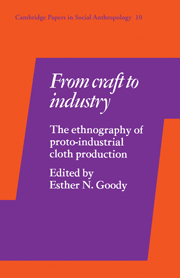Book contents
- Frontmatter
- Contents
- List of figures, maps and illustrations
- List of tables
- Notes on contributors
- 1 Introduction
- 2 On commoditization
- 3 Daboya weavers: relations of production, dependence and reciprocity
- 4 The tailors of Kano City
- 5 Production and control in the Indian garment export industry
- 6 Harris Tweed: construction, retention and representation of a cottage industry
- Notes
- References
6 - Harris Tweed: construction, retention and representation of a cottage industry
Published online by Cambridge University Press: 04 August 2010
- Frontmatter
- Contents
- List of figures, maps and illustrations
- List of tables
- Notes on contributors
- 1 Introduction
- 2 On commoditization
- 3 Daboya weavers: relations of production, dependence and reciprocity
- 4 The tailors of Kano City
- 5 Production and control in the Indian garment export industry
- 6 Harris Tweed: construction, retention and representation of a cottage industry
- Notes
- References
Summary
INTRODUCTION
The durable luxury textile called Harris Tweed is produced exclusively on the Scottish offshore islands known as the Outer Hebrides or Western Isles. This string of islands, some thirty miles to the west of mainland Scotland, has been regarded as a problem area since its incorporation into the United Kingdom, along with the rest of Scotland, in 1707. The history of the ‘Hebridean Problem’ is similar to that of the ‘Irish Problem’, at least with respect to the nineteenth century. In the 1830's, 40's and 50's, potato famines and unrest about land reform brought the poverty of the Highlanders and Hebrideans, as well as that of their Irish neighbours, to the attention of the national conscience. The difference between the Irish and Hebridean views of the situation at the time is reflected in the different histories of the two areas since 1880. The Irish Land League, which was the chief organ of protest in Ireland, was vociferous in its calls for national self-determination and land reform. The latter was envisaged as, at the least, returning the land to the people, at the most, leading to nationalization of land. Although the Highland Land League was affiliated to its Irish counterpart, it exhibited a greater divergence between nationalist and socialist philosophies. The roots of both the Labour Party in Scotland and the Scottish Nationalist Party can be traced back to the Highland Land League (Hunter 1974; Kellas 1966). Differences in attitude to land reform were even more important. Highland Land Leaguers made repeated pleas for land reform, but this did not refer to the abolition of landlord-tenant relationships in favour of small-farm ownership, let alone the nationalization of land.
- Type
- Chapter
- Information
- From Craft to IndustryThe Ethnography of Proto-Industrial Cloth Production, pp. 166 - 199Publisher: Cambridge University PressPrint publication year: 1982



